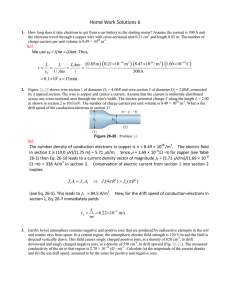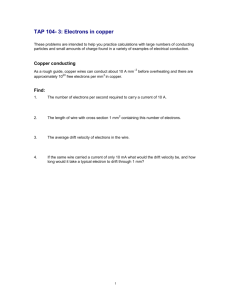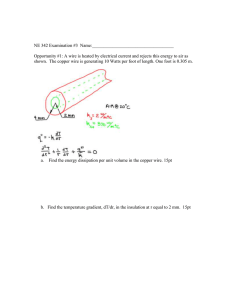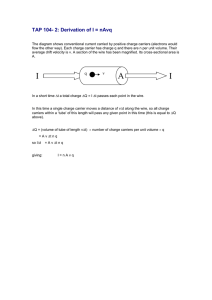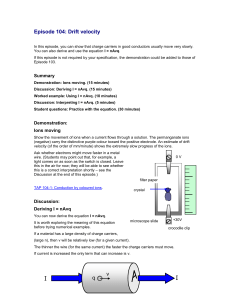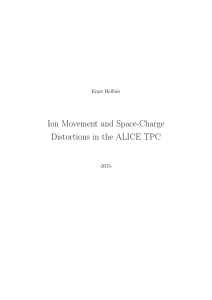Home Work Solutions 6
advertisement
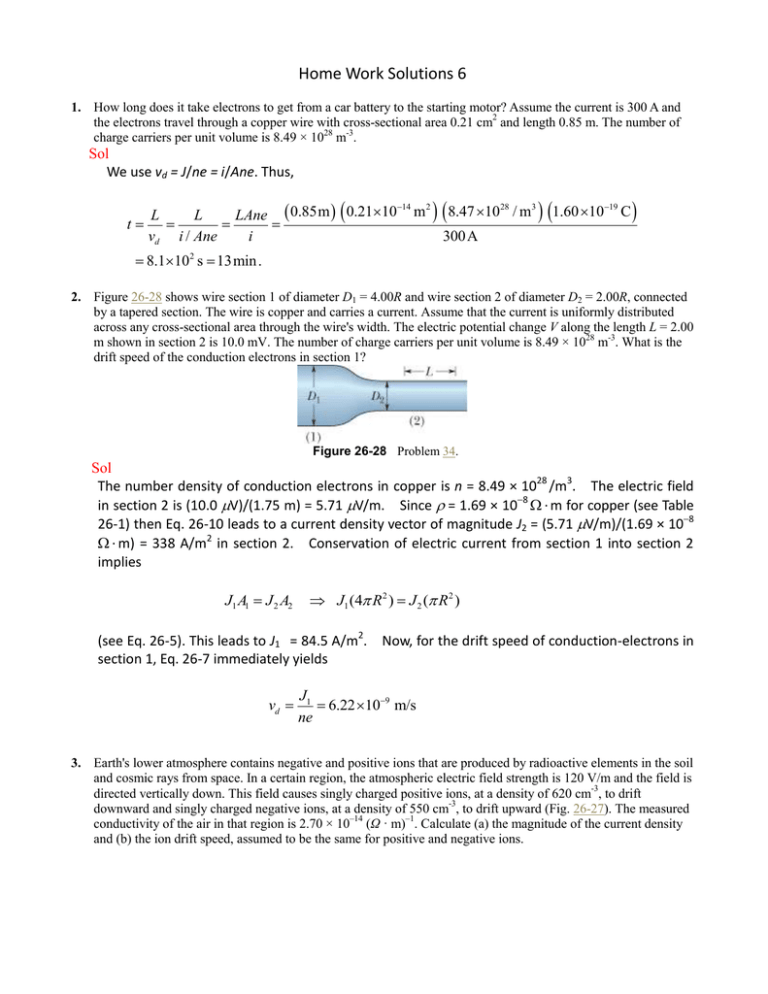
Home Work Solutions 6 1. How long does it take electrons to get from a car battery to the starting motor? Assume the current is 300 A and the electrons travel through a copper wire with cross-sectional area 0.21 cm2 and length 0.85 m. The number of charge carriers per unit volume is 8.49 × 1028 m-3. Sol We use vd = J/ne = i/Ane. Thus, 14 2 28 3 19 L L LAne 0.85m 0.2110 m 8.47 10 / m 1.60 10 C t vd i / Ane i 300A 8.1102 s 13min . 2. Figure 26-28 shows wire section 1 of diameter D1 = 4.00R and wire section 2 of diameter D2 = 2.00R, connected by a tapered section. The wire is copper and carries a current. Assume that the current is uniformly distributed across any cross-sectional area through the wire's width. The electric potential change V along the length L = 2.00 m shown in section 2 is 10.0 mV. The number of charge carriers per unit volume is 8.49 × 1028 m-3. What is the drift speed of the conduction electrons in section 1? Figure 26-28 Problem 34. Sol The number density of conduction electrons in copper is n = 8.49 × 1028 /m3. The electric field in section 2 is (10.0 V)/(1.75 m) = 5.71 V/m. Since = 1.69 × 108 ·m for copper (see Table 26-1) then Eq. 26-10 leads to a current density vector of magnitude J2 = (5.71 V/m)/(1.69 × 108 ·m) = 338 A/m2 in section 2. Conservation of electric current from section 1 into section 2 implies J1 A1 J 2 A2 J1 (4 R2 ) J 2 ( R2 ) (see Eq. 26-5). This leads to J1 = 84.5 A/m2. Now, for the drift speed of conduction-electrons in section 1, Eq. 26-7 immediately yields vd J1 6.22 109 m/s ne 3. Earth's lower atmosphere contains negative and positive ions that are produced by radioactive elements in the soil and cosmic rays from space. In a certain region, the atmospheric electric field strength is 120 V/m and the field is directed vertically down. This field causes singly charged positive ions, at a density of 620 cm-3, to drift downward and singly charged negative ions, at a density of 550 cm-3, to drift upward (Fig. 26-27). The measured conductivity of the air in that region is 2.70 × 10–14 (Ω · m)–1. Calculate (a) the magnitude of the current density and (b) the ion drift speed, assumed to be the same for positive and negative ions. Figure 26-27 Problem 32. Sol We use J = E = (n+ + n–)evd, which combines Eq. 26-13 and Eq. 26-7. (a) The magnitude of the current density is J = E = (2.70 10–14 / ·m) (120 V/m) = 3.24 10–12 A/m2. (b) The drift velocity is vd E n n e 2.70 10 14 m 120 V m 640 550 cm3 1.60 1019 C 1.70 cm s. 4. Swimming during a storm. Figure 26-30 shows a swimmer at distance D = 35.0 m from a lightning strike to the water, with current I = 78 kA. The water has resistivity 30Ω · m, the width of the swimmer along a radial line from the strike is 0.70 m, and his resistance across that width is 4.00 kΩ. Assume that the current spreads through the water over a hemisphere centered on the strike point. What is the current through the swimmer? Figure 26-30 Problem 36. Sol Since the current spreads uniformly over the hemisphere, the current density at any given radius r from the striking point is J I / 2 r 2 . From Eq. 26-10, the magnitude of the electric field at a radial distance r is I E w J w 2 , 2 r where w 30 m is the resistivity of water. The potential difference between a point at radial distance D and a point at D r is V D r D Edr D r D w I I 1 I 1 r , dr w w 2 2 r 2 D r D 2 D( D r ) which implies that the current across the swimmer is i | V | w I r . R 2 R D( D r ) Substituting the values given, we obtain (30.0 m)(7.80 104 A) 0.70 m i 4.43 102 A . 3 2 (4.00 10 ) (38.0 m)(38.0 m 0.70 m)
